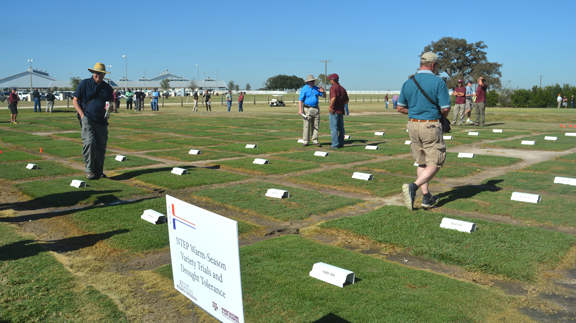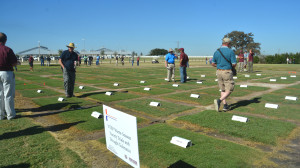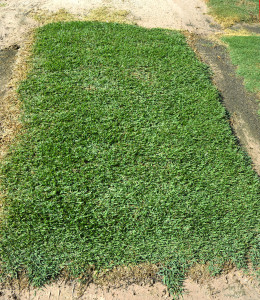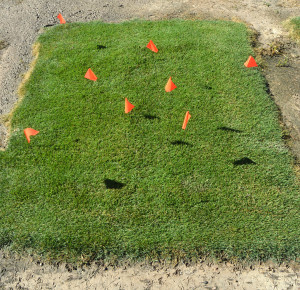Farm & Ranch
There’s more to picking a good grass than just green

By: Kay Ledbetter
AgriLife Extension turfgrass trials match purpose to environment
Writer: Kay Ledbetter, 806-677-5608, [email protected]
Contact: Dr. Casey Reynolds, 979-845-0603, [email protected]
COLLEGE STATION – Not every grass is a good fit for home lawns, golf courses or athletic playing fields, so turfgrass researcher Dr. Casey Reynolds is testing varieties and comparing them side by side under Texas conditions as a part of the National Turfgrass Evaluation Program.
Reynolds, a Texas A&M AgriLife Extension Service turfgrass specialist in College Station, is joined by Dr. Matt Elmore, an AgriLife Extension turfgrass specialist who is growing additional trials at the Texas A&M AgriLife Research and Extension Center at Dallas.
“The primary objective of these NTEP trials is to evaluate new and emerging varieties for their performance in southern and southeastern transition zone environments,” he said. “So, what that means is we plant grasses such as zoysiagrass, Bermuda grass, seashore paspalum and St. Augustine, because we know these species persist and do well in the southern United States and we evaluate them on an equal level.”
Reynolds said the AgriLife Extension trials at both locations include approximately 100 grass varieties, and the College Station trials were recently featured at the Texas A&M AgriLife Turfgrass and Landscape Field Day.
“We’ll take, for example, the NTEP zoysiagrass trial comprised of 30 or so different varieties and compare them to each other based on quality, color, leaf texture, density, drought hardiness, performance and pest incidence,” he said.
The National Turfgrass Evaluation Program then takes that data from this location and data from throughout the U.S. at other cooperating universities and compiles it.
“This way a producer or a customer or anyone who is interested in planting a new variety can look and see an independent source of data and use it to evaluate whether or not that grass is a good fit for their needs,” Reynolds said.
“For instance, we may have a zoysia grass that may do great in terms of how it performs under drought, and next to it one that may look a little better, but the data tells us it may not perform as well under drought,” he said.
NTEP is a great way to organize all that data and compare varieties.
That’s an important thing to understand when selecting a grass variety, Reynolds said, “because we all know in the southern United States drought is always an issue and will continue to be an issue. We certainly want to breed and select grasses that do well in hot, dry climates.
During the turfgrass field day, Reynolds asked the clients attending to place a flag in the plots that they thought looked the best.
“It was interesting to see that a lot of the flags were placed in the same plots,” he said. “I personally like a grass that has dark color, that has finer leaf texture and that has good density.”
Reynolds stood near two plots of grass with a big difference in texture, one rated four on texture and the other an eight. Looking at the data, he said, the eight is going to be a much nicer grass, “especially if you are on a golf course tee box, where texture is probably a bigger deal than if you are on a home lawn.
“But if you are a landscaper comparing the two species and you look at the drought data, you might say, ‘I don’t care how fine the texture is if I can’t keep it alive, texture doesn’t matter.’ So your selection may change.”
Reynolds said it is important not to get hung up on having the latest new variety – sometimes if it is not broke, why try to fix it?
“With the data we collect, we try to do it in a manner that is going to be reflective upon how people are going to view these grasses when they get to their home or their golf course or athletic field and whether it is going to fit into their environmental conditions.”
Results of the NTEP trials at College Station and Dallas can be found at http://www.ntep.org/. Other information on turfgrass species and variety selection for Texas can be found at https://aggieturf.tamu.edu/texas-turfgrasses.
-30-
Find more stories, photos, videos and audio at http://today.agrilife.org
Farm & Ranch
Managing Show Cattle Through The Winter

By Heather Welper
Husband and wife duo, Heather and Calvin Welper, are the Co-Owners and Operators or Two C Livestock, located in Valley View, Texas.
The pair’s operation has a show cattle focus where they raise and sell purebred heifers of all breeds and club calf Hereford steers.
When it comes to show cattle, the Welpers know a thing or two including how to prepare for the cold winter months and the Texas major show season run.
To read more, pick up a copy of the November edition of North Texas Farm & Ranch magazine, available digitally and in print. To subscribe by mail, call 940-872-5922.

Farm & Ranch
Double M Ranch & Rescue

By Hannah Claxton, Editor
As the sun rises each day, so do the dozens of mouths that Meghan McGovern is responsible for getting fed. Rather than the sounds of a rooster crowing, McGovern hears the bellows and bleats of a variety of exotic deer, the chortle of kangaroos, the grunts of water buffaloes, and the chirps of a lemur.
Nestled against the banks of the Red River, the Double M Ranch and Rescue, with its high game fences and deer sprinkling the landscape,s its in stark contrast to the surrounding ranches.
“Having deer is kind of like eating potato chips- you can never actually have just one,” said McGovern with a laugh.
McGovern has several herds to take care of- fallow deer, axis deer, water buffalo, goats, and bison. In smaller numbers, there’s also a few kangaroos, a lemur, a potbelly pig, a pair of zebras, a watusi, and a few horses.
To read more, pick up a copy of the November edition of North Texas Farm & Ranch magazine, available digitally and in print. To subscribe by mail, call 940-872-5922.

Farm & Ranch
Acorn Toxicity

By Barry Whitworth, DVM, MPH
With the prolonged drought, most pastures in Oklahoma end up in poor condition. With the lack of available forage, animals may go in search of alternative foods.
If oak trees are in the pastures, acorns may be a favorite meal for some livestock in the fall. This may result in oak poisoning.
Oak leaves, twigs, buds, and acorns may be toxic to some animals when consumed.
To read more, pick up a copy of the November edition of North Texas Farm & Ranch magazine, available digitally and in print. To subscribe by mail, call 940-872-5922.

-

 Country Lifestyles2 years ago
Country Lifestyles2 years agoScott & Stacey Schumacher: A Growth Mindset
-

 Country Lifestyles8 years ago
Country Lifestyles8 years agoStyle Your Profile – What your style cowboy hat says about you and new trends in 2017
-

 HOME8 years ago
HOME8 years agoGrazing North Texas – Wilman Lovegrass
-

 Outdoor10 years ago
Outdoor10 years agoButtercup or Primrose?
-

 Country Lifestyles5 years ago
Country Lifestyles5 years agoAmber Crawford, Breakaway Roper
-

 Equine1 year ago
Equine1 year agoThe Will to Win
-

 Country Lifestyles9 years ago
Country Lifestyles9 years agoJune 2016 Profile – The man behind the mic: Bob Tallman
-

 Country Lifestyles8 years ago
Country Lifestyles8 years agoDecember 2016 Profile, Rusty Riddle – The Riddle Way







